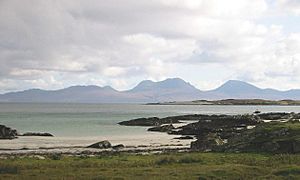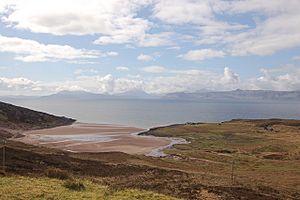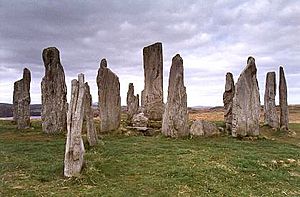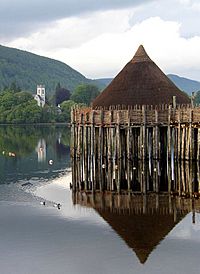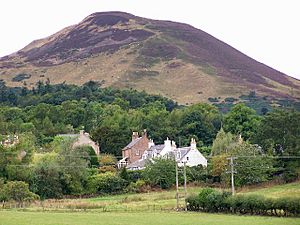Timeline of prehistoric Scotland facts for kids
This timeline of ancient Scotland lists important places and events from Scotland's past, long before written history began. This time is called the prehistoric period. It starts when the first humans arrived and ends when the Romans came to southern Scotland around 1 AD, bringing written records with them.
No signs of Neanderthals or early humans have been found in Scotland from the Ice Ages. The first clues of people show up only after the ice melted, around 11,000 BC. Since then, Scotland's land has changed a lot, both by nature and by people.
Back then, sea levels were much lower because so much water was still frozen in ice. This meant that the Orkney islands and many of the Inner Hebridean islands were connected to the mainland. Even Great Britain was linked to Continental Europe. A big part of what is now the North Sea was dry land until about 4000 BC. This made it easier for early people to travel to western and northern Scotland.
Many ancient sites are found in the Highlands and Islands. This might be because fewer people live there today, so the sites haven't been disturbed as much. Also, thick layers of peat in these areas help preserve stone objects. The Orkney islands also have many important remains, often found in sandy, farmable land. Old stories and respect for these structures might have helped keep them safe.
Understanding the different periods of human history can be tricky. The Paleolithic period lasted until the ice melted. The Mesolithic period was when people were hunter-gatherers. The Neolithic period began when people started farming. These changes happened at different times in different parts of Scotland. Some sites were used for very long periods, so the lines between these eras can be blurry.
Contents
Understanding the Timeline
This timeline uses letters to show what kind of evidence was found at each site.
| Letter | Type | What it means |
|---|---|---|
| (B) | Bone | Human or animal bones, teeth, and shells. |
| (E) | Environmental | Natural events like changes in land or weather. |
| (F) | Building foundations | Signs of old buildings, like disturbed ground, wood, or shaped stones. |
| (M) | Metal | Metals used by people for tools or jewelry. |
| (O) | Organic material | Things that were once alive, like plants or animal remains. |
| (P) | Pottery | Usually broken pieces of pots, sometimes whole ones. |
| (S) | Stone | Stone tools, stones used for building, standing stones, or natural rock features. |
Early Stone Age (Palaeolithic)
During the coldest parts of the Ice Age, all of Scotland was covered in ice. Even when famous cave paintings were made in France around 14,000 BC, most of Scotland was still icy. Humans began to live in Scotland during a warmer period, but much later than in southern Europe because of the cold. So far, only one place has clear proof of early Stone Age human life in Scotland.
| Date (BC) | Location | What was found | Type |
| 12,000 | Biggar | Stone tools made of Flint were found at Howburn Farm in 2005. They were dated in 2009. | (S) |
| c. 10,000 | Islay | Stone tools from the Ahrensburgian culture were found near Port Askaig in 2015. This was probably a summer camp for hunters traveling by boat. | (S) |
Middle Stone Age (Mesolithic)
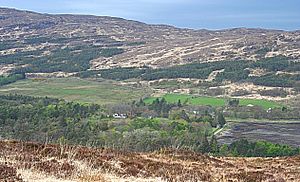
The Middle Stone Age in Scotland is known for many stone tools. These tools show that people were hunter-gatherers. They often used small, sharp stone pieces called microliths. Most tools were made from flint pebbles found on beaches, but other local stones were also used.
Most things from this period were made of wood or animal parts, which usually don't last long in Scotland's acidic soil. However, some bone tools have been found where conditions were better. Shell middens (piles of shells), fish bones, and burnt remains like hearths and hazelnut shells are also common. These can help scientists figure out the age of the sites. Many Middle Stone Age sites are found near the coast. No burial sites from this period have been found in Scotland yet, but human remains have been discovered in the Oronsay middens. A few dwelling sites have also been found.
| Date (BC) | Location | What was found | Type |
| 10,800 | Islay | A flint arrowhead was found near Bridgend. This might be from a warmer period around 12,000-11,000 BC. It's the earliest Middle Stone Age find in Scotland. | (S) |
| 11,000–9640 | Scotland-wide | The Loch Lomond Stadial was a very cold period. No human activity has been found from this time. | (E) |
| 8500 | Cramond | Remains of a temporary camp with over 3,000 items, including about 300 stone tools. | (O, S) |
| 8240 | South Queensferry | The outline of Scotland's "oldest house," an oval about 7 meters (23 feet) across. It was likely used in winter. | (O, F, S) |
| 8000 | Aberdeenshire | Possibly the world's oldest calendar, found at Warren Field in 2004 using aerial photos. | (F) |
| 7700–7500 | Rùm | Burnt hazelnut shells and tiny pieces of charcoal at Farm Fields, Kinloch, show a settlement. This was thought to be the oldest sign of people in Scotland until the Cramond site was confirmed in 2001. | (O) |
| 7500 and 5500 | Applecross | A shell midden (waste heap) and rock-shelter at Sand in Wester Ross. The Inner Sound area is important for studying early Middle Stone Age settlers. | (B, S) |
| 6700 | Colonsay | A midden pit with thousands of burnt hazelnut shells, all from the same year. Smaller pits nearby were used for roasting. | (O) |
| 6500 | Skye | A rock shelter and midden site at An Corran in Staffin, likely connected to the Sand site. | (O, S) |
| 6500 | Islay | Stone tools, including 250,000 flints, found at Bolsay. | (S) |
| 6500–5500 | Rùm | A beach site above Loch Scresort with holes for stakes, suggesting tent-like homes. | (F, O) |
| 6000 | Jura | Three stone hearths (fireplaces) and traces of red ochre. These are the earliest dated stone structures found so far. | (S) |
| 6000 | Coastal areas | The Storegga Slides caused a huge tsunami that reached 25 meters (82 feet) above normal tides. Signs of widespread flooding have been found, especially in the north and east. | (E) |
| 5300–4300 | Oronsay | Five middens with huge amounts of seashells, some fish bones, antler, and human remains. The middens seem to have been filled at different times of the year. | (B) |
New Stone Age (Neolithic)
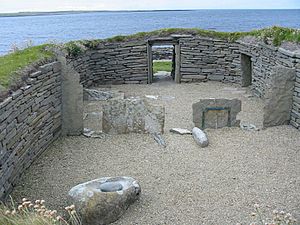
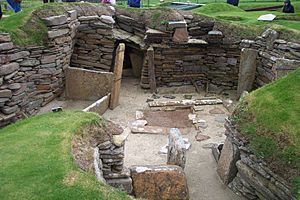
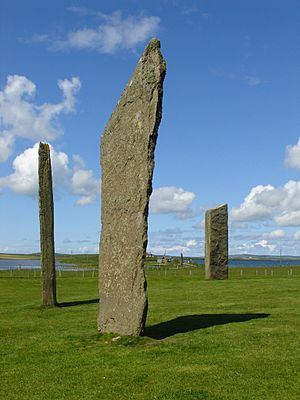
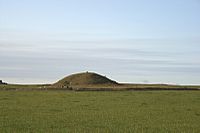
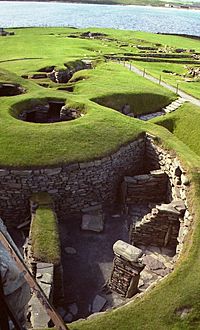
The New Stone Age in Scotland shows a big change from the hunter-gatherer ways. During this time, complex societies developed. They were able to build very large structures. Progress wasn't always steady; sometimes, building advances were followed by periods where things didn't change much.
For example, the Balbridie site is a huge timber hall. Only two other similar sites have been found in Scotland. No timber buildings of this size were built again until the Saxons arrived about 4,000 years later. The amazing New Stone Age monuments in Orkney were built around the same time as the Ancient Egyptian culture began. This was more than 500 years before the Great Pyramid of Giza was built!
| Date (BC) | Location | What was found | Type |
| 3900–3200 | Aberdeenshire | Balbridie timber hall. This building was 26 meters (85 feet) long and 13 meters (43 feet) wide. It might have had a roof 10 meters (30 feet) high and could hold up to 50 people. Nearby, Braeroddach Loch has the earliest proof of pastoralism (raising animals) from 3780 BC. | (F, O) |
| 3700–2800 | Papa Westray | Knap of Howar New Stone Age farmstead. It's probably the oldest preserved house in northern Europe. Pieces of Unstan pottery were found here. People lived in this house for 900 years. | (P, S) |
| 3600 | Meikleour | Cleaven Dyke cursus, a unique structure in Scotland, and Herald Hill long barrow (burial mound). | (S) |
| 3500–2500 | West Lothian | Digs at Cairnpapple Hill found pottery bowls and stone axe heads, showing early rituals. A large henge (circular monument) was built here 1,000 years later. | (P, S) |
| 3500–2000 | Orkney | A site dug up at Ness of Brodgar since 2003 has shown houses, decorated stone slabs, a huge stone wall 4 meters (13 feet) wide, and a large building 25 meters (82 feet) long and 20 meters (66 feet) wide, called a New Stone Age "cathedral." | (P, S) |
| 3400 | Shetland | The Scord of Brouster site includes six or seven walled fields and three round stone houses. It has the earliest hoe blades found in Scotland. | (S) |
| 3200–2800 | North Uist | Eilean Dòmhnuill in Loch Olabhat might be Scotland's earliest crannog (lake dwelling). Its last phase looks similar to Knap of Howar. | (P, S) |
| 3200–2950 | Orkney | The Barnhouse Settlement, another group of buildings, including one that might have been used for community meetings. | (S) |
| 3100–2500 | Orkney | Skara Brae has ten clustered houses and is Northern Europe's most complete New Stone Age village. | (O, S) |
| 3150 | South Ronaldsay | The Tomb of the Eagles had 16,000 human bones and 725 bird bones, mostly from white-tailed sea eagles. This chambered tomb was used for 800 years or more. | (B, S) |
| 3100 | Orkney | The Stones of Stenness are four remaining large stones of a henge. The tallest is 5 meters (16 feet) high. | (S) |
| 3000 | Argyll | Kilmartin Glen has 350 New Stone Age and Bronze Age relics within a 10 kilometer (6 mile) area, including Dunadd hill fort. | (S) |
| 3000? | Hirta | Pottery pieces and a quarry for stone tools found on Mullach Sgar. Stone hoe-blades, grinders, and Skaill knives found in the Village Bay storage cleitean (stone huts). The exact date is uncertain, between 3500 and 1500 BC. | (P, S) |
| 3000–2500 | Westray | At Links of Noltland, a diamond-shaped figurine was found in 2009. It might be the earliest picture of a human face found in Scotland. It's called the Westray Wife. | (S) |
| 2900–2600 | Lewis | The Callanish Stones are one of Scotland's best stone circles. The 13 main stones, 1 to 5 meters (3 to 16 feet) tall, form a circle about 13 meters (43 feet) wide. | (S) |
| 2700 | Orkney | Maeshowe, a large and special chambered cairn and passage grave. It's built so its main room is lit up during the winter solstice. Vikings looted it and left many runic writings. | (S) |
| 2500 | Shetland | Jarlshof is the most famous archaeological site in Shetland. The earliest finds are pottery from this time, but the main settlement is from the Bronze Age. A nearby site is dated to 3200 BC. | (P) |
| 2500 | Orkney | Ring of Brodgar, a stone circle 104 meters (341 feet) wide. It originally had 60 stones inside a ditch up to 3 meters (10 feet) deep. It's thought to have taken 80,000 hours of work to build. | (S) |
| 2500? | Hoy | The Dwarfie Stane tomb, made from one huge block of red sandstone with a hollowed-out room inside. This style is very different from other New Stone Age sites in Orkney. | (S) |
| 2460 | Rùm | The earliest evidence of trees being cut down and land being farmed, found from a peat sample near Kinloch. | (O) |
Bronze and Iron Ages
From the start of the Bronze Age (around 2250 BC) to about 2000 BC, fewer large new stone buildings were constructed. Studies of pollen show that forests grew more, and less land was farmed. In Orkney, people started burying their dead in small stone boxes (cists) away from the big stone monuments. A new culture, the Beaker people, became important.
Metalworking with bronze and iron slowly came to Scotland from Europe over a long time. As the Bronze Age continued, Scotland's population grew to maybe 300,000 people. People lived very different lives during the Bronze Age. For example, finds at Traprain Law (near modern Edinburgh) suggest that priests there held ceremonies similar to those in mainland Europe.
During the 1st millennium BC, the Iron Age began. It's fair to talk about a Celtic culture in Scotland then. However, we still don't know much about the Picts and the people who lived just before them. The Stirling hoard was found in 2009. It's considered the most important discovery of Iron Age metalwork in Scotland.
| Date (BC) | Location | What was found | Type |
| 2250–1950 | Sutherland | The Migdale Hoard is an early Bronze Age find at Skibo Castle. It includes two bronze axes, armlets, anklets, a necklace of bronze beads, ear pendants, and jet buttons. | (M) |
| 2000 | West Lothian | At Cairnpapple Hill, later finds include Beaker pottery from 2000 BC, and burial cists and graves from the Iron Age or later. | (P, S) |
| 2000 | Forteviot | A Bronze Age tomb with burial treasures. It had the remains of an early Bronze Age ruler on white quartz pebbles and birch bark, with a bronze and gold dagger, a wooden bowl, and a leather bag. | (M, S) |
| 2000 | Nairn | The Clava cairns of Balnuaran are three large circular chamber tombs surrounded by a ring of boulders. They are the best examples of 45 such cairns in Inverness-shire. | (S) |
| 2000 | Inverness | A burial cist at Culduthel had barbed arrowheads and an archer's wristguard with gold rivets. | (M, S) |
| 2000 | Argyll | Rock art found in Achnabreac forest near Lochgilphead includes some of the largest ring marks in Britain. It's likely connected to nearby Kilmartin Glen, suggesting it was used for a thousand years. | (S) |
| 1600–1100 | South Uist | Cladh Hallan, the only place in the UK where prehistoric mummies have been found. | (O, S) |
| 1500? – 200 | Aberdeenshire | Bennachie, a famous hill with Bronze and Iron Age remains, including a 20-meter (66-foot) wide roundhouse. | (S) |
| 1500 BC – 150 AD | East Lothian | Traprain Law, a hill fort and burial site that covered up to 16 hectares (40 acres). It was an important place for the Votadini people. | (M, S) |
| 1255 | Forth Valley | A wooden disc-wheel with three parts found at Blair Drummond Moss. This is the earliest proof of wheeled transport in Britain. | (O) |
| 1159± | Iceland | A volcano called Hekla erupted, making farming conditions much worse. This might have cut the Bronze Age population in half. Tool making went down, but more weapons were made, suggesting a time of trouble. | (E) |
| 1000 | Melrose | The fort on Eildon Hill has 5 kilometers (3 miles) of walls. It might have held 3,000 to 6,000 people at times. | (O) |
| 1st millennium BC | Skye | The remains of Dun Ringill fort look like both a broch (round tower) and a complex Atlantic roundhouse. | (S) |
| 800 BC onwards | Shetland | The main settlement of Jarlshof includes a smithy (metal workshop), a group of wheelhouses, and a later broch. People lived here until Viking times. | (P, S) |
| 800 | Perthshire | A collection of bronze objects found in a peat bog at Corrymuckloch. It included three axeheads, a sword blade, and a large ladle, which is unique in Britain. | (M) |
| 700–500 | Argyll | The "Ballachulish Goddess" – a life-sized wooden figure of a woman with quartz pebbles for eyes. It was found under a wicker structure in peat at Ballachulish. It was probably placed there on purpose. | (O) |
| 600? | Ross-shire | Dun an Ruigh Ruaidh on the southwest shore of Loch Broom is an early example of a complex Atlantic roundhouse. Brochs might have developed from these. | (S) |
| 400 | Edinburgh | A chariot burial found at Newbridge in 2001. This was the first such find in Scotland. | (M) |
| 300 | Skye | The remains of a bridge from a lyre (a stringed instrument) found at High Pasture Cave. This small, broken piece is the earliest find of a stringed instrument in western Europe. | (W) |
| 200 | Kirkcudbright | The Torrs Pony-cap and Horns, three mysterious bronze objects with fancy Celtic designs, from about 200 BC. | (M) |
| 100? | Mousa | Broch of Mousa was built during the last period of broch building. It stands about 13 meters (44 feet) high and is the best example of these unique Scottish structures. Dun Carloway broch on Lewis is also well preserved and from a similar time. | (S) |
| 100 | Stirling | The Stirling hoard, made up of four gold torcs (necklaces). They were made between 300 BC and 100 BC and were clearly buried on purpose long ago. | (M) |
Sites with Unknown Dates
Some important sites haven't been dated yet, or they contain items from many different times. The items from Hirta and Burghead might be from the Dark Ages, which was several centuries after the Romans arrived and written history began.
| Location | What was found | Type |
| North Sea | A flint scraper found in a core sample from the seabed between Norway and Shetland. This area was above sea level between 16,000 and 8000 BC, but the tool could also have been lost from a boat later. | (M, O, S) |
| Assynt | Discoveries in the Inchnadamph caves suggest humans hunted animals like lynx, brown bear, Arctic fox, and reindeer. There's some evidence the site might be as old as the late Stone Age, but carbon dating suggests around 6000 BC. | (M, O, S) |
| Moray | Many old items from different periods were found in the Culbin Sands. In the late 1800s, "searching for arrows" was a popular local hobby. The National Museum of Scotland has 29,500 items, but many more have been lost. | (M, O, S) |
| Fetlar | Funzie Girt dyke is a wall that runs north-south across the island. Its date is unknown, but it was probably a boundary marker from the New Stone Age. The wall divided the island so clearly that the Norse people treated Fetlar as two separate islands. | (S) |
| Aberdeenshire | Petrospheres called "Carved Stone Balls" of unknown age. They are also found on Orkney, Skye, Iona, and Lewis. The ones in Aberdeenshire are found with unusual "recumbent" stone circles, suggesting they are from the New Stone Age. | (S) |
| Hirta | "Horned structures" in Gleann Mòr, including the "Amazon's House." Nothing like them exists anywhere else in Britain or Europe, and their original use is unknown. They might be Pictish from 400 to 900 AD, or they could be older. | (S) |
| Moray | The chambered well at Burghead was found in 1809. This underground structure is unique in Scotland. It's probably from the Dark Ages, but it might be older. | (S) |
Images for kids
-
The ruins of Dun Carloway Iron Age broch
See also
 In Spanish: Anexo:Cronología de la prehistoria de Escocia para niños
In Spanish: Anexo:Cronología de la prehistoria de Escocia para niños


